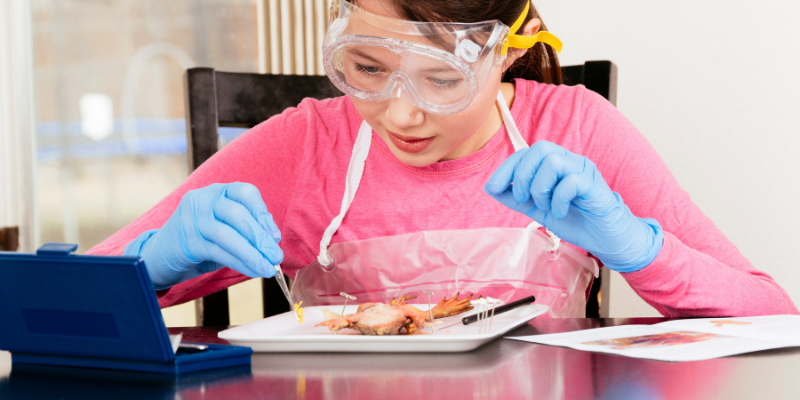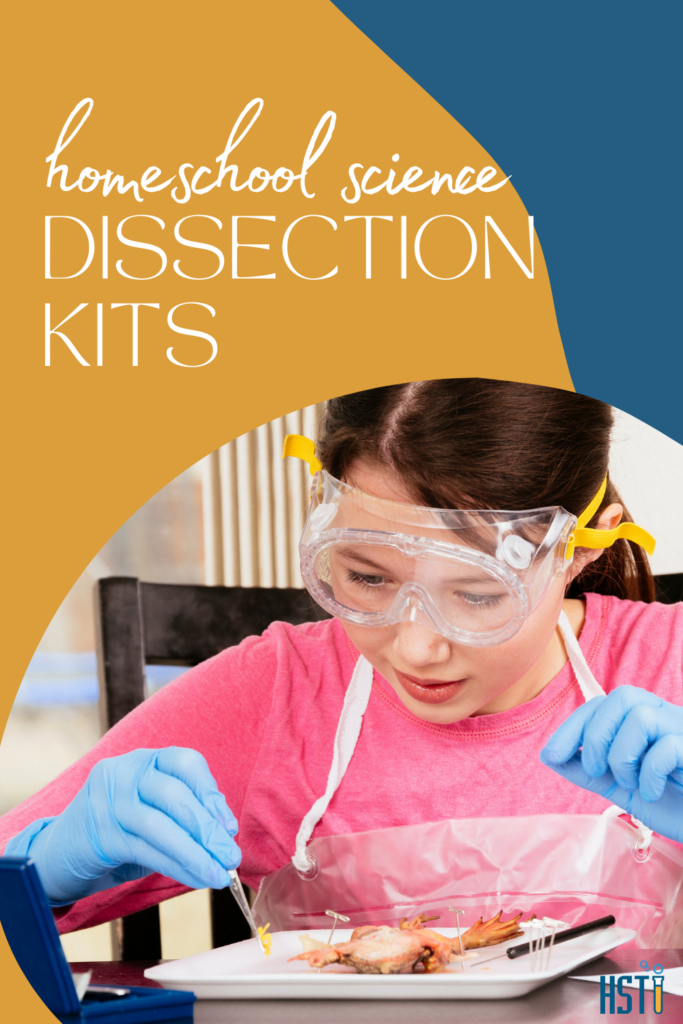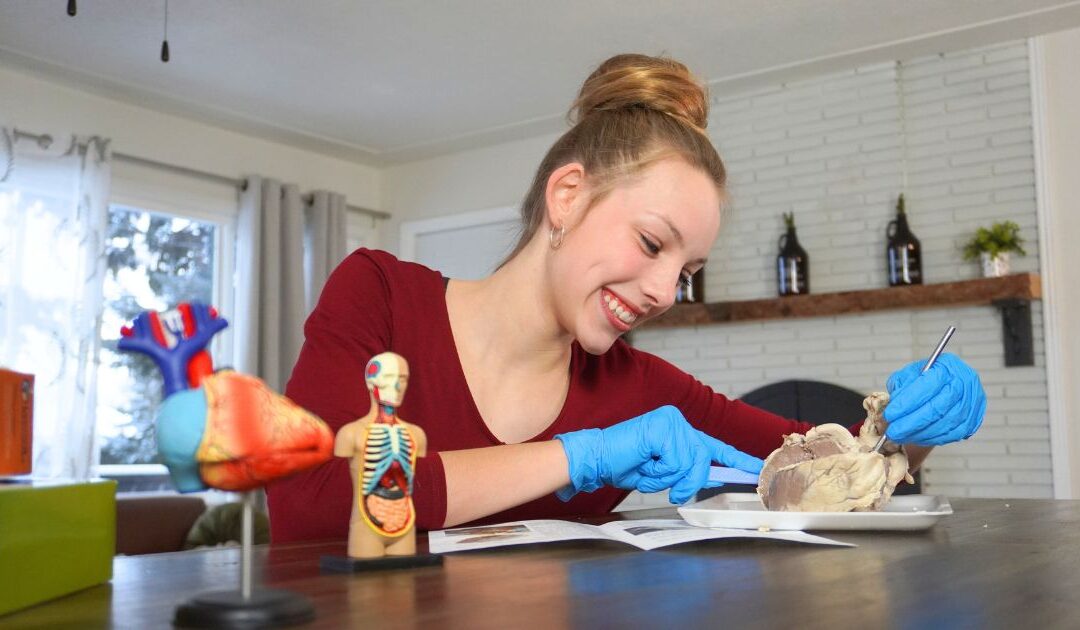Homeschool science dissection kits are an important part of a homeschool science curriculum. But, many parents often get caught up in thinking that high school science labs need to be hard. Not so!
There are many homeschool science dissection kits that are available to you that will help you get through your dissection labs. These home science tools will make your job as a homeschool parent even easier. The kits often come with all of the dissection supplies you need to do a lab including, dissection tools, formaldehyde preserved dissection specimens, and dissection guides. Each animal dissection kit allows you to easily and safely create a dissection lab for your own life sciences curriculum. Let’s dig in!

What do Dissection Kits Contain?
As kits can vary based on factors such as price, the specimen, etc, we’ve included here some of the things you need to look for in a basic dissection set.
In order to properly study a specimen, you will need the proper tools. That’s the first thing to look for in the lab kit. Does it have:
- A scalpel
- Small scissors
- Forceps or tweezers
- Pipet
- Needles (to hold down the specimen)
You can find our dissection toolset here. It is of great value and includes everything you need to begin a dissection lab. In addition to the items listed above, ours includes a ruler, extra scalpel blades, and curved and straight teasing needles. All of these items come in a nice storage case, as well.
In addition to the tools listed above, you’ll need a dissecting pan or tray. We prefer ones like this that have padding that needles easily stick into, without leaving the tray unusable again.
The trays and tools are reusable over and over. To reuse these tools, simply clean them with boiling water swabs or another sterilizer.
Many times in dissection, a magnifying glass can come in handy. This is something that you may already have lying around the house from another science kit or another science lesson you’ve done in the past. Some of our kits come with a magnifying glass (like this one in our brain dissection kit), so be sure to check the specifics of each kit to know if the one you order does.
Investing in disposable gloves is something you’ll want to do, as well. This is part of dissection safety that we’ll cover below.
Animal Homeschool Science Dissection Kits
Dissection is a tradition in biology labs and can offer tangible benefits to science learning at the middle school and high school levels. However, not every child is comfortable (or willing) to complete these labs.
That’s ok. Be sensitive to your child’s needs in this area. You will be dealing with real animal specimens. If you try to force activity for the sake of learning, learning isn’t beneficial. There are curricula that provide alternatives to animal dissection kits by replacing dissection with other activities.
What kind of dissection kit should you get?
Selecting the right dissection kit is entirely dependent on your goals. Dissection kits are a simple and cost-efficient way to make life science and biology for kids more interesting. Large animal dissection kits are appropriate for middle-school, high-school, and college-level biology labs. Look below for more information about basic vs advanced dissections.
Standard Home Science Tools kits are high quality and include preserved specimens such as frog dissection kits, fetal pigs, or fish. You can also choose a mammal organ dissection kit that includes organs from various animals. Or, choose single-organ kits such as cow eyes, heart dissection kits, and sheep brains.
Using the dissection guides inside the kits, you’ll learn techniques for mastering dissections. The guides include photos, which help ensure that you use the tools safely and correctly. They can also help you make lesson plans that will match the learning goals you have in mind.
We also have kits specific to the Apologia science curriculum. It contains everything needed for four optional high quality, hands-on homeschool dissection labs in Apologia’s Exploring Creation with Biology course, 3rd edition, including:
- Dissecting tools
- Dissection guides
- 4 preserved dissection specimens (packaged separately)
Note that this kit can also be used for the 2nd edition of Apologia’s biology curriculum. This Apologia biology lab kit provides materials for an essential part of Apologia’s Biology course.
Basic vs Advanced Dissection Kits – where to start.
When you are beginning science dissection labs, you will want to start with introductory kits in order to build skills in dissecting. Starting with Life Science kits that include simple invertebrates like earthworm dissection, grasshopper dissection, and frog dissection. These help your student to build skills that will allow a deeper understanding of science.
Advancing next to intermediate dissections like crayfish dissection, starfish dissection, frog dissection, fish dissection, and clam dissection is a natural next step to allow for a natural flow in building skills.
More advanced dissections will include those done in biology labs. Dissections here include cow eye dissection, owl pellet dissection, pig dissection kit, and sheep heart dissections.
Homeschool science dissection kits, like the ones listed above, save you both money and time. Rather than having to buy your dissection products and supplies individually, our dissection kits provide you with everything you need – all bundled in one convenient box!
Homeschool Science Dissection Kit Safety
Follow these steps to ensure there are no accidents in your dissection lab.
- Never leave students unattended—especially young students.
- Have students cut “away” from themselves and others.
- Guide students to use the correct tool. They can make dissection cuts with scissors (easier to use) or scalpels (which take skill).
- Instruct students to place the scalpel blade face down when making cuts (not up).
- Change scalpel blades with a remover box.
- Require students to wear nitrile gloves, eye protection, and lab aprons (disposable or reusable).
- Direct students to use a dissection tray or dissection pan while working. It will contain liquids and prevent sharp tools from slipping. The insert is there to support pinning.
A note about our preserved specimens.
The main preservative used in our specimens is formaldehyde. In sealed, original packaging, our preserved specimens are guaranteed to remain fully preserved and free of decay for six months from the date of purchase.
Once the original package is opened, use the specimen within one month, or for best results, observe the following storage procedures:
- Store specimen in heavy-duty, zip-lock plastic bags to minimize drying between dissections.
- Specimen will slowly dry out or become contaminated in zip-lock bags; add a teaspoon of Specimen Holding Fluid to retain moisture.
- Freezing or refrigeration is not necessary and may damage fragile tissues.
Homeschool science dissection kits are a great way to help your young scientist develop the skills they need and learn about life science and biology!
What has been your experience with dissection labs? Sharing your experience helps to encourage other homeschool families!






